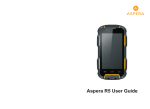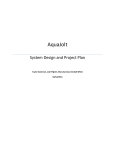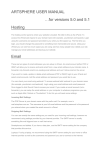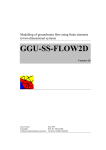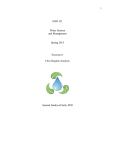Download Carbon footprint user manual v1.3
Transcript
February 2010 The carbon footprint tool for industrial projects, small and medium size. User manual Table of contents Introduction............................................................................................................... 3 a. General principles............................................................................................ 3 b. Presentation of the tool.................................................................................... 4 Step 1: Filling the ‘General info & results’ sheet ................................................... 5 a. Project information........................................................................................... 5 b. Project and reference scenario description ..................................................... 5 Step 2: Filling the “Project emissions” and “Reference scenario emissions” sheets. ....................................................................................................................... 7 a. Construction phase.......................................................................................... 7 b. Operation phase .............................................................................................. 7 Step 3 : Results transmission and exploitation ..................................................... 9 Focus on the main types of industrial projects ................................................... 10 a. Renewable energy projects ........................................................................ 10 b. Energy efficiency projects .......................................................................... 10 c. Waste collection and treatment projects..................................................... 11 d. Wastewater treatment projects................................................................... 11 Introduction AFD supports low carbon growth in the energy sector by promoting energy efficiency and renewable energy. In this context, AFD provides a simplified tool for measuring greenhouse gas emissions of projects. This tool is derived from the Carbon Balance® tool developed by ADEME (http://www2.ademe.fr/servlet/getDoc?id=38480&m=3&cid=96), the French Environment and Energy Management Agency and Jean-Marc Jancovici (www.manicore.com, in French only). This tool is presented in the form of an Excel spreadsheet, and this manual details how to use it. a. General principles The main objective of the carbon footprint tool is to provide an estimation of the volume of greenhouse gas (GHG) emitted or saved annually by a project. This tool is simplified so as to be usable before a project is implemented. Data needed to fill the model is very limited, and generally known by the project holder before implementation. Results provided by the tool are also easily exploitable. However, this estimate is not meant to replace a thorough carbon analysis of a project, or a precise calculation for a future CDM (Clean Development Mechanism) project. This tool can be used to estimate GHG emissions for all types of industrial projects of small to medium size, i.e. with an investment cost less than 15 million euros. For projects of larger size, a more complete version of the tool is available on AFD’s website: https://climatechange.afd.fr All six GHG included in the Kyoto Protocol are taken into account in the calculation tool: CO2, CH4, N2O, HFC, PFC and SF6. In order to be able to aggregate results from different projects and to produce figures easy to handle, yearly emissions from a project are averaged over a project’s lifetime to obtain a single figure: annual average emissions. If a project has a climate mitigation impact, a second figure is produced: annual average emission reductions. The Excel spreadsheet will be completed: - either by the project promoter who will then transmit it to the bank; - or directly by the technical team of the bank. b. Presentation of the tool The Excel tool is divided into five sheets: 1. General info & results This sheet is divided into two parts: the first one presents general information regarding the project; the other the results produced by the tool, including GHG emission reductions of the project, electricity and fossil fuel savings and the cost of an avoided ton of CO2. 2. Project emissions This sheet estimates the GHG emissions of the project, during construction and operation phases. 3. Reference scenario emissions This sheet estimates the GHG emissions of the reference scenario. Reference scenario is defined as the most likely scenario without the project. This sheet is to be filled only when the project is a climate friendly one, i.e. a project avoiding GHG emissions. If the project has no positive impact on climate, this sheet is not to be filled. 4. Emission factors An emission factor is a coefficient estimating the amount of pollutant (a greenhouse gas here) emitted when an activity occurs (e.g. transportation, utilisation of materials, energy consumption) This last sheet of the tool provides: - The emission factors used in the other sheets; - Conversion tools for energy units; - Emission factors not used in the other sheets but potentially useful when the calculation needs to be refined; This sheet is not to be modified by the user, data is provided to ensure the transparency of the tool. 5. Conversions Conversion tables for energy units are available in this sheet. Step 1: Filling the ‘General info & results’ sheet The only part to be filled is ‘Project information’. The second part ‘Carbon footprint results’ will be automatically completed when steps 2 and 3 are filled. a. Project information 1. Name of project 2. Country, select from drop-down list This selection is needed to use the emission factor for electricity from national grids. The list of emission factors for electricity for most countries of the world is available on the last sheet (lines 140 to 280). AFD uses the emission factors provided by the International Energy Agency. 3. Date of completion (auto-completion of this field) 4. Project cost It represents the total investment cost for the project. Maintenance and operation costs are not included in this figure as they are not necessarily known when the calculation is done. As a consequence, the cost of an avoided ton of CO2 will only be linked with the investment cost of the project. 5. Project duration The project duration is the estimated lifetime of a project when in operation. Standardised durations are used: 50 years for hydropower projects; 30 years for transportation projects; 20 years for other types of projects. When the construction phase emits GHG, its duration will be taken equal to one year. However, if the standard lifetimes for projects given above do not correspond to a specific project, the project holder can modify it, and justify its choice in the ‘project description’ field. b. Project and reference scenario description 1. Project description and definition of the project perimeter The project holder will briefly describe the context of the project, the investment and the objectives of the project. The project perimeter will also be described in this field. In order to determine which GHG emissions will be estimated in the calculation (both for the project and the reference scenario), it is necessary to determine the project perimeter. The project perimeter needs to include all emission sources that are under control of the project holder and significant in the final result. Practically, the method is based on the principles laid by the GHG Protocol (www.ghgprotocl.org). It defines three scopes, corresponding to increasing perimeters: - Scope 1 (direct): emissions directly linked to the activities of an entity (fossil fuel consumption, company-owned vehicles…) - Scope 2 (indirect): purchase of electricity and heat not produced on-site; - Scope 3 (indirect): production of purchased material, product use, outsourced activities, waste disposal… « Overview of scopes and emissions across a value chain » The GHG Protocol: A Corporate Accounting and Reporting Standard. World Resources Institute, 2004 In order to have a complete understanding of the emissions induced by the funding of a project, it is important to take into account emissions from scope 1, 2 and 3. However, as it has been described in the general principles, the method aims at estimating the order of magnitude of emissions. As a consequence, calculations will only use a limited number of factors, which are described further in this manual. 2. Choice and description of reference scenario In order to assess avoided emissions by a climate friendly project, it is necessary to estimate emissions that would reasonably occur in the absence of the project, i.e. emissions of the reference scenario. As detailed in the introduction of this document, reference scenario is defined as the most likely scenario in case of the project is not implemented. In case of the modernisation or retrofit of existing facilities, reference scenario will be taken as the situation before the project is implemented. In case of a ‘greenfield’ project (new facilities) reference scenario will be defined as a project using less environmentally friendly technologies, based on common national practices and standards. The last part of this guide will help project promoters define the reference scenario for their project. The perimeter of the reference scenario has to be the same as the perimeter of the project. Step 2: Filling the “Project emissions” and “Reference scenario emissions” sheets. Both sheets are identical, and filling them is very intuitive: - Yellow cells correspond to the nature of activites. They are to be filled using the drop-down lists. - Corresponding quantification of activities is to be filled in the white cells. It is important to take care of units. If needed, conversion tables are available in the last sheet “emission factors” (lines 65 to 85). Data to be filled in these cells are those included in the project and reference scenario perimeter, as defined above. Numerous cells may be non relevant to a specific project and will left blank. At the top of the sheet, on the left, a ‘reset’ button can be used to empty all cells, in order to start the calculation over. This button should be used carefully, as all data entered by the user are deleted and cannot be retrieved. a. Construction phase 1. Forest clearing Forest clearing related emissions are estimated using areas cleared, expressed in hectares, and the type of surfaces cleared. The model is based on the assumption that carbon contained in the wood, as well as part of the carbon in the soils will be emitted in the atmosphere in the form of CO2. Only clearings directly linked with the project are taken into account. 2. Construction materials This part of the tool takes into account emissions linked with the construction of facilities or infrastructures. These emissions are mainly due to the production of materials: steel, cement, plastics… Cells are to be filled with the mass of material used, in tons. 3. Energy consumed by construction machinery To fill this part, the project holder will estimate the amount, in tons or in litres, of fuel used by machinery during the construction of the project. b. Operation phase 1. Fossil fuel consumption for operation The cells are to be filled with the amount (in tons or in litres) of fuel annually consumed by the facility included in the project perimeter. It does not include the electricity bought from the national grid. Fuel consumed in a diesel generator to locally produce electricity is to be taken into account in this section. 2. Electricity produced by fossil fuels If electricity is produced within the perimeter of the project (i.e. not taken from the grid) from fossil fuel consumption and the only available data is the electricity production, this part is to be filled with the annual electricity production. The default efficiency of the facility producing this energy is set equal to 30%, but may be modified by the used if different from this value. 3. Electricity consumed by project Cell is to be filled with the electrical annual consumption, taken from the national gird, in kWh. Electricity loss along the transmission lines is taken into account, and equal to 10% by default. If project holder has more precise information about this data, it can modify it. 4. Solid waste GHG emissions from a solid waste facility depend on different factors: climate, the nature of waste, and their treatment method. For each type of waste, it is therefore necessary to enter the type of climate and the treatment type. Waste quantities have to be filled in tons per year. 5. Wastewater operations Wastewater production is to be quantified in cubic meters per year. For each type of waste, it is necessary to precise the treatment method used. Step 3 : Results transmission and exploitation Once completed, the file with all four sheets is to be sent to the bank or AFD. The following table provides some orders of magnitude of the investment cost of an avoided ton of CO2. These results come from projects assessed by AFD in various sectors. Sector Wind Hydro EE Fuel switch Biomass Geothermal pwr Average cost of avoided tCO2 28 10 18 32 16 16 The carbon footprint provides estimation of the order of magnitude of emission reductions generated by a climate friendly project. If figures are important enough, a project manager may want to assess the possibility to develop a CDM (Clean Development Mechanism) project. Many guides are available in different languages on the internet, among which a booklet developed by the French Ministry for Economy, Industry and Employment, the French Ministry for Ecology, Energy, Sustainable Development and Town and Country Planning and the French Global Environment Fund (FFEM), entitled “Developing a CDM or JI project to reduce greenhouse gas emissions; Identifying opportunities and Getting started”. This guide is available in French on: http://www.ffem.fr/jahia/webdav/site/ffem/users/admiffem/public/Publications/Guide_francais_du_MDP _MOC_2008.pdf and in English on: http://www.ffem.fr/jahia/webdav/site/ffem/users/admiffem/public/Plaquette_FFEM/Kyoto_angl.pdf This guide provides clear and precise information on: - elements on international context; - opportunities of CDM; - how to integrate CDM in an investment planning. Focus on the main types of industrial projects a. Renewable energy projects For an installation producing electricity with renewable resources (solar, wind, geothermal, tidal, small hydro), emissions predominantly result from the construction phase, and come from the following stages: - civil engineering: transportation of materials, excavations, etc; - potential clearing of the area; - emissions linked to the production of materials used for the project (essentially steel and cement). NB: For hydroelectricity projects, the flooding of wooded areas can lead to significant methane emissions. In this case however, the projects are small-scale and these emissions will therefore be considered negligible. Similarly, in case of a population displacement, emissions associated to it will result from the necessary construction of housing and infrastructures (roads, etc.). Operation-induced emissions include maintenance staff transfers, equipment repairs, and possible punctual maintenance interventions (dredging, etc.). These emissions are secondary compared to those induced by the construction, and will therefore be neglected in this first approach. The reference scenario is built on the basis of UN-approved CDM methodologies: it will however be simplified in order to facilitate the calculation, which aims at determining rough estimates of a project’s carbon footprint. - In the case of a network-connected renewable energy project, the reference scenario is a project producing the same amount of energy, but with the emission factor of the national grid. In the ‘reference scenario emissions’ sheet, the only information that needs to be filled out is at line 74, namely the annual amount of energy produced by the project. - In the case of a decentralised renewable energy project, the reference scenario should be built on a case by case basis. As a reference scenario one should generally take a circumstance in which the energy produced by the project would have been produced with the means available in that specific geography. Diesel generators will usually be in question. In the ‘reference scenario emissions’ sheet, the category that needs to be filled out is at line 62, namely the electricity produced with fossil fuels. b. Energy efficiency projects In the case of an energy efficiency project on an existing installation, one should consider the construction emission as negligible, unless significant civil engineering works are necessary. The reference scenario is the situation before the implementation of the project. In most cases, the project planner will need to fill in the expected global energy consumption (‘Project emissions’ sheet) and the current (or pre-project) global energy consumption (‘reference scenario emissions’ sheet). In the case of a greenfield project or for new installations, the project planner will need to mention in the project description why it constitutes a more efficient alternative to common practices in that country (i.e. implementing the best available practices). Construction and plant operation should be taken into account. The base scenario will be that of the country’s usual practices. c. Waste collection and treatment projects In the case of waste collection and treatment projects, one should take into account construction and exploitation emissions. The base scenario should be built on a case by case basis, although it will often match the situation before the project. Waste quantities should be identical for the project and for the base scenario. Some definitions and explanations are given below, regarding solid waste disposal sites (definitions given by the IFC, that AFD would like to thank for sharing information about this topic): Anaerobic managed solid waste disposal sites: These must have controlled placement of waste (i.e., waste directed to specific deposition areas, a degree of control of scavenging and a degree of control of fires) and will include at least one of the following: (i) cover material; (ii) mechanical compacting; or (iii) levelling of the waste. Semi-aerobic managed solid waste disposal sites: These must have controlled placement of waste and will include all of the following structures for introducing air to waste layer: (i) permeable cover material; (ii) leachate drainage system; (iii) regulating pondage; and (iv) gas ventilation system. Unmanaged solid waste disposal sites - deep and/or with high water table: All SWDS not meeting the criteria of managed SWDS and which have depths of greater than or equal to 5 metres and/or high water table at near ground level. Latter situation corresponds to filling inland water, such as pond, river or wetland, by waste. Unmanaged shallow solid waste disposal sites: All SWDS not meeting the criteria of managed SWDS and which have depths of less than 5 metres. Uncategorised solid waste disposal sites: Only if countries cannot categorise their SWDS into above four categories of managed and unmanaged SWDS, the MCF for this category can be used. d. Wastewater treatment projects As is the case for solid waste treatment projects, wastewater treatment projects should take into account construction and exploitation emissions. The base scenario will often be the situation before the implementation of the project, and water amounts should be identical for both scenarios.












